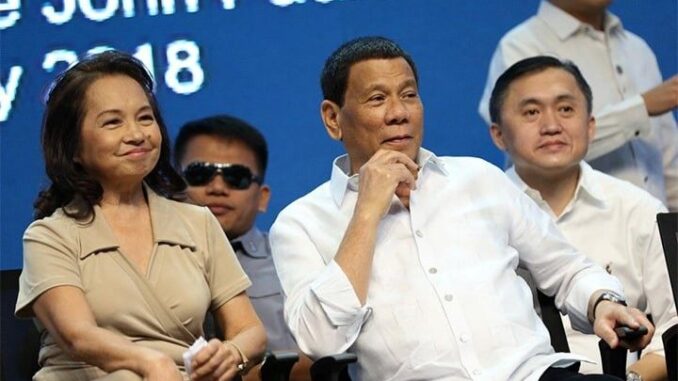
MANILA, Philippines — Years before the Rodrigo Duterte’s presidency ushered in the highest number of business deals with Beijing in Philippine history, Gloria Macapagal-Arroyo’s administration opened the floodgates for Chinese investments.
This is based on the findings of a June 2024 study from the United States-based research group AidData, which tracked Chinese investments from 2000 to 2023. The report looks at China’s economic engagements with four Philippine presidents and the extent to which the country benefited from them.
Arroyo had “publicly embraced China as a friend” despite the two countries’ maritime disputes, according to the report, which AidData representatives presented to the media on Thursday, September 12.
The study found that the former president courted Chinese investments at a time when Beijing was actively working to bring local enterprises overseas as part of the “going out” policy.
As a result, Beijing’s development finance to the Philippines spiked by more than 950% during her presidency (from US$88 million to US$931 million), particularly in energy and telecommunications projects.
“What is significant about looking at China’s investments in the Philippines is it’s highly responsive to bilateral relationships between Manila and Beijing,” Samantha Custer, director of AidData, said at a briefing on Wednesday, September 11.
“You see a lot of difference in how China has engaged with the Philippines depending on who is in power. So with sympathetic or more open administrations that were keen to work closely with Beijing, you see a huge ramp up in investment,” she said.
AidData
Soft launching: Arroyo to Aquino
In Arroyo’s first year in office in 2001, the Philippines received its first major development project funded by China: an $88 million loan for an irrigation project in Ilocos Sur. This project was described as akin to a “trial run” for China’s even larger investments in water and power supply in the next two decades.
By Arroyo’s final year in 2010, Chinese investments peaked at $931 million, driven by major projects like a coal-fired power plant and wastewater treatment in Metro Manila.
In contrast, the Aquino administration (2010-2016) saw a decline in Chinese investments due to Manila’s frostier relations with Beijing. But investment levels during Aquino’s time never “vanished completely,” Custer said, with Beijing pumping more funds toward smaller-scale goodwill projects to stoke positive public opinion.
“In this ‘quiet’ phase of PRC-Philippine relations, Beijing was likely cultivating people-to-people ties to create a more conducive environment for a resurgence of cooperation with the next administration, once Aquino stepped out of power,” the study said.
Surge in capital: Duterte
Duterte’s Build, Build, Build infrastructure program saw an even greater spike in China-backed projects, particularly in his political bailiwick of Davao.
Under Duterte, China-funded projects saw the fastest rate of approval, with investments reaching record levels. Two decades of data show that 85% of Chinese-funded projects in Davao occurred during Duterte’s presidency, AidData found.
The biggest China-backed projects in the early years of Duterte’s tenure were in hard infrastructure sectors (industry, mining, and construction; energy; and water). Meanwhile, telecommunications garnered ample attention from Chinese financiers during this period, according to the study.
Debt for aid. However, the Philippines under Duterte was also incurring a hefty amount of debt due to the flood of Chinese development projects and Beijing’s “less generous” terms, the study pointed out.
“Despite warming relations, Beijing did not become more generous to the Philippines in terms of the cost of accessing its financing,” the study said.
Based on AidData’s analysis, for every $1 of aid that Beijing gave the Philippines in 2016, it issued $167 of debt. Three years later, China’s terms had now cost the Philippines $211 of debt for every $1 of grant funding.
“The reason comes down to a common feature in the PRC’s development finance globally: it bankrolls a small number of high-cost hard infrastructure projects from which it expects an economic return,” the study said.
Investments as politics
Beijing has also been keen on bankrolling projects in “politically important regions,” including home regions of Philippine political leaders.
For instance, from 2000 to 2023, the National Capital Region, the country’s political epicenter, received the most projects by count (45 projects).
Meanwhile, Arroyo’s bailiwick of Central Luzon received the greatest value of China-backed projects ($2.7 billion).
AidData
“Beijing orients investments to highly populated, urban areas with elevated human development levels,” the study noted.
“These areas offer large consumer bases, strong corporate connections, better infrastructure, and an educated workforce conducive to Beijing’s interests in opening market opportunities for Chinese goods, services, and [foreign direct investments,” it added.
While Beijing had doled out large sums to finance development projects in the Philippines, “these benefits do not yet appear to trickle down in a visible way to Filipinos,” according to AidData.
“As [People’s Republic of China] financing increased, Filipinos surveyed were more likely to say they struggled to afford food and shelter, an important indicator of financial health,” the study added.


Be the first to comment